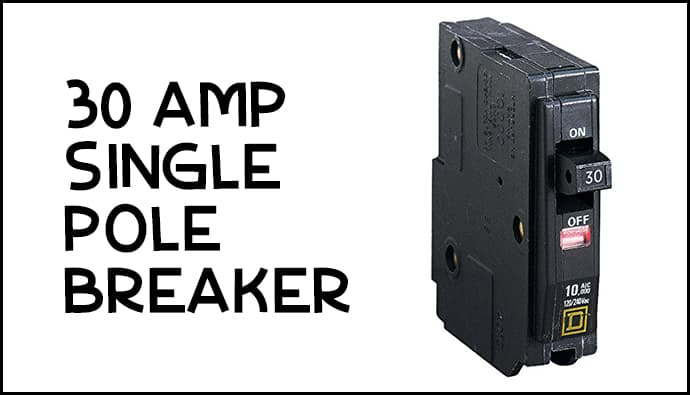30 Amp Breaker – Everything You Need to Know

As electrical components and systems experts, we understand the importance of choosing and installing the right breaker for your electrical panel. The right breaker protects your system from several electrical problems and safety hazards. But like most electrical equipment, a variety of circuit breakers are available—each with distinct uses. In this case, we will discuss 30-amp breakers—including what they are, why you might need one, and what size wire for 30-amp breakers.
What is a 30-Amp Breaker?
Let's start with the basics. As the name implies, a 30-amp circuit breaker is designed to handle a maximum current of 30 amps. This makes it ideal for high-powered appliances and equipment like air conditioners, water heating systems, and dryers.
Like all circuit breakers, it works by detecting when the current in a circuit exceeds its rated capacity (max of 30 amps). When that happens, the breaker automatically trips—interrupting the flow of electricity and protecting the electrical system from damage (including fires).
Types of 30 Amp Circuit Breakers
When shopping for 30-amp breakers, you'll typically have to choose between a 30-amp single-pole breaker or a 30-amp double-pole breaker. So, which one do you pick? Simply put, the difference between single-pole and double-pole breakers lies in the size, wiring, and circuit they support. Here's what we mean…
30-Amp Single-Pole Breaker

30-amp single-pole breakers can be identified by the narrow design of their switches on the electrical panel. But perhaps the most distinct characteristic is the use of one "hot" wire and one neutral pole (i.e., it only has two openings).
A 30-amp single-pole breaker is typically installed on 30A/120V circuits. This means that it's used for systems that need up to 30 amps at 120 volts. While rare in residential settings (compared to 20-amp breakers), 30-amp single-pole breakers have their uses—especially in commercial and industrial settings for specialized appliances and tools.
30-Amp Double-Pole Breaker

A 30-amp double-pole breaker is defined by the presence of two "hot" wires and a single neutral wire – i.e., it has two poles that take up roughly two slots in a circuit breaker box.
30-amp double-pole breakers can handle double voltage (240 volts)—whether as a single 240v circuit or two 120v circuits). This makes them convenient for heavy appliances like electric dryers and water heaters in residential settings.
What is a 30-Amp Circuit Breaker Used For?
While rare in the United States, 30-amp breakers are used in both residential and commercial electrical systems to protect circuits rated for 30 amps. It is useful when running a large load from equipment and appliances like air conditioners, water heaters, cooking units, and dryers.
It's important to note that a 30-amp circuit breaker should only be used for circuits that are designed for that amount of power. Using a 30-amp breaker for a circuit designed for less or more than 30 amps can result in potential hazards. More specifically, here's what happens when a circuit breaker is too low or too high.
What Happens if I Install a Breaker That is Too Low?
As elaborated in this post on how a circuit breaker works, the idea behind a breaker is to automatically cut power in a circuit when anything above the rated amps tries to flow through the electrical system.
For example, let's say you have an electric dryer that requires 30 amps to run. If you install a breaker that is rated lower than the dryer's load (e.g., 20 amps), it will trip every time you turn on the dyer since the appliance is drawing more amps than the breaker can allow.
What Happens if I Install a Breaker That is Too High?
While a low-rated breaker leads to continuous tripping, a circuit breaker that is TOO high puts you at risk of electrical damage and fires.
If you have a 30-amp circuit but install a 50-amp breaker, the safety device will not trip in time when the electrical flow exceeds safe levels. As a consequence, the overcurrent may damage your dryer, which is designed to run on 30 amps.
Another issue is the wiring. As we will discuss later, 30-amp circuits use wiring that can only handle 30 amps of power. Anything above that may lead to overheating—possibly causing a fire.
How Many Amps Can a 30-Amp Circuit Breaker Handle?
Theoretically, a 30-amp breaker can handle up to 30 amps. But in practice, it's a whole 'nother thing. According to the National Electrical Code (NEC), an electrical circuit must only conduct 80% of a breaker's rated capacity for an extended period.
Why? Because running the maximum load poses the risk of heat buildup and frequent tripping—considering some appliances generate a temporary spike in the current draw when turned on.
30-Amp Breaker Wire Size
A common question when it comes to circuit breakers is "What size wire for 30-amp breaker?"—and rightfully so. Precise wire sizing is crucial for an electrical circuit's proper functioning and safety.
One of the most important considerations regarding wire sizing is the gauge, or AWG (American Wire Gauge). AWG is a standardized measurement system for the diameter of a wire—and helps determine the ampacity a wire can withstand before being compromised. The higher the AWG, the "thinner" or smaller the wire size.
So, what size wire for 30-amp breakers? Assuming you're using copper wires, the recommended 30-amp breaker wire size is an AWG of 10. Please note that a 10-gauge wire is the minimum size—but you can use a thicker gauge wire. This is because a wire can safely conduct less power than it was rated for. The only inconveniences would be the extra cost of a thicker wire and the challenges with installation.
Looking for 30-Amp Breakers?
There you have it – everything you need to know about 30-amp breakers! By understanding the basics of 30-amp breakers, you can ensure the safety and efficiency of your electrical system for years to come. And with this guide, you can feel confident in choosing the right breaker from our expansive inventory for your electrical needs.




